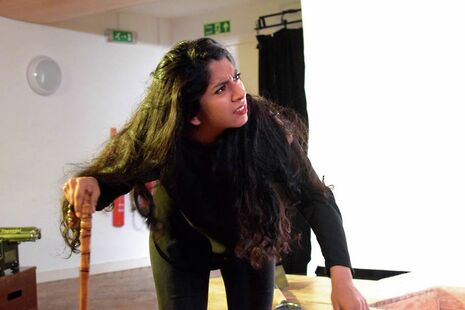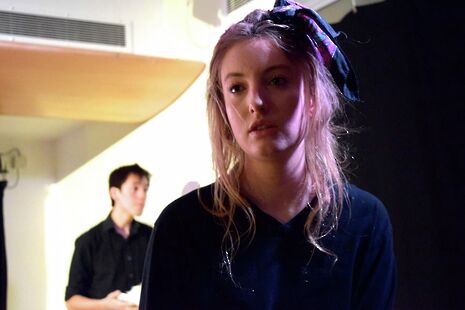“It’s not really meant to be a nice trip to the theatre”
Todd Gillespie finds out more about 13 Objects and the immersive vignettes soon to be taking over Pembroke New Cellars

Directors Eve Gatenby and Isabelle Higgins have not given themselves an easy task. Howard Barker’s 2006 play 13 Objects, composed of 13 small plays including monologues and duologues, is anything but straightforward. “Singular stories are nice – they’re cute – but they’re just a bit basic”, Gatenby muses. Each vignette focuses on a different object – a tea cup, a spade, and a rattle, among others – and questions the meanings and power that we give to inanimate things.
Observing their rehearsal in the claustrophobic but quaintly-lit Pembroke Old Cellars, I noticed a strong atmosphere of collaboration. With a cast of just three (Alex Franklin, Grace Etheredge, and Shimali De Silva; all freshers), the directors have not been afraid to run with the script, creating as they go. The cast’s job is also highly testing: each member must play very different characters in consecutive vignettes, changing persona in seconds. “The language is so contrasting,” notes Etheredge. De Silva mentions the morbidity of some “traumatic” vignettes, displaying physical violence between actors and even the destruction of their objects.
“Each cast member must play very different characters in consecutive vignettes, changing persona in seconds”
The play opens with two prisoners of war being directed to dig a grave, not being told who is due to be buried there. Despite the surrealism, in many ways, suggests Gatenby, the play is “far more realist than something that sells itself as such”. Like life, it has no introduction. We, like the prisoners, are simply thrown into confusion and forced to battle with the power that others have over us. Other pieces portray the tantrum of a queen played out through her rattles, and the narcissistic ‘youth’ personified by a young man lamenting the gift of a camera from his father.

The intensity of the subject matter and the unconventional nature of the play might lead to accusations of pretentiousness (as previous reviews of the performance elsewhere have put forward). Yet the down-to-earth directors are clearly aware of this risk (“pretentiousness is something I hate,” insists Higgins). While trying to maintain the integrity of the script, they have ruthlessly cut it down. Leaving out two whole vignettes and heavily trimming the others, the play now lasts under an hour, making it much more accessible than the two-hour original. The directors have also scrapped any accents, and the actors are wearing all-black for all of their characters. The play is paired with specially-made video art and music, producing a highly sensual experience for the audience.
In an unconventional staging of an unconventional play, immersion is a priority for the directors: “it’s all about compression.” The audience will be at the centre (perhaps symbolic of the focus on our own psyches), surrounded on three sides by the actors. Higgins laments the lack of immersive theatre in Cambridge, insisting her actors will be ready to unsettle, irritate, and even disgust their audience.
Macabre, amusing and subversive: for adventurous directors and actors fully invested in the risk of their work, come to 13 Objects with an open mind and a reflective attitude. “It has the capacity to be beautiful,” insists Higgins, “but it’s not really meant to be a nice trip to the theatre.” Be ready to be disturbed.
The Pembroke Players’ 13 Objects runs from 7th – 11th March at Pembroke New Cellars, 7pm
 Interviews / You don’t need to peak at Cambridge, says Robin Harding31 December 2025
Interviews / You don’t need to peak at Cambridge, says Robin Harding31 December 2025 News / Unions protest handling of redundancies at Epidemiology Unit30 December 2025
News / Unions protest handling of redundancies at Epidemiology Unit30 December 2025 Comment / What happened to men at Cambridge?31 December 2025
Comment / What happened to men at Cambridge?31 December 2025 Features / ‘Treated like we’re incompetent’: ents officers on college micromanagement30 December 2025
Features / ‘Treated like we’re incompetent’: ents officers on college micromanagement30 December 2025 Theatre / We should be filming ADC productions31 December 2025
Theatre / We should be filming ADC productions31 December 2025








